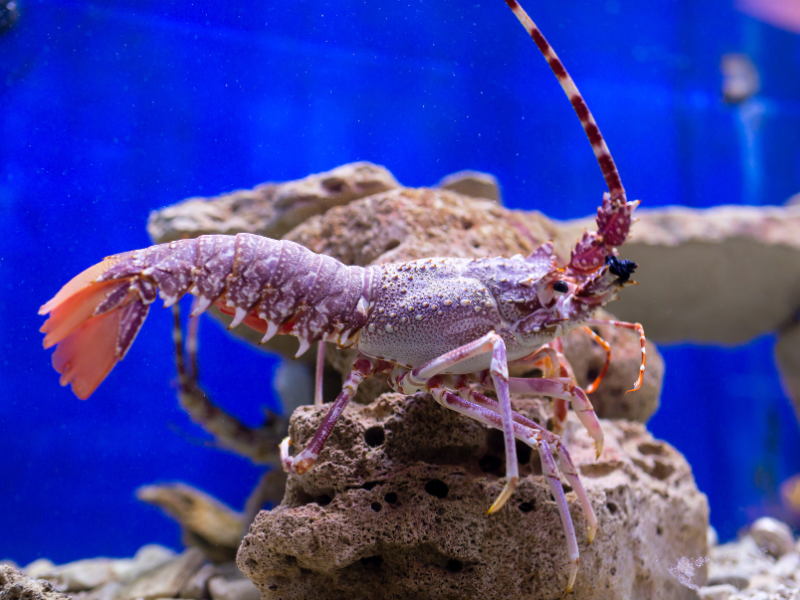Palinurus elephas
Common Spiny Lobster
Common Spiny Lobster

The Common Spiny Lobster, scientifically known as Palinurus elephas, is a formidable and engaging crustacean for the dedicated expert aquarist. In its natural habitat across the Eastern Atlantic and Mediterranean Sea, it inhabits rocky crevices and seabeds, often in areas with significant water movement. Replicating this environment is key to its successful care. A very large aquarium is non-negotiable, not only to accommodate its substantial adult size but also to dilute its high waste production and maintain stable water chemistry. Strong water flow, created by powerheads or circulation pumps, is critical for delivering high levels of dissolved oxygen and mimicking the currents of its native environment.
The aquascape should be constructed with large, stable rock formations that create numerous caves and overhangs. These structures provide essential shelter and allow the lobster to establish a territory, reducing stress. Because this species is known to uproot and dig, rooted plants are unsuitable; any decorations must be heavy or securely fixed to prevent them from being toppled. A securely fitted lid is mandatory, as these lobsters are surprisingly adept at climbing and can easily escape an open-top tank.
As a carnivore, its diet should be varied and consist of high-quality, protein-rich foods. A rotation of frozen seafood like shrimp and mussels, occasional live foods, and nutrient-fortified sinking pellets will meet its dietary needs. An alternate-day feeding schedule helps prevent overfeeding and manage the significant bioload it produces. Its territorial disposition means that tank mates must be chosen with extreme care; slow-moving or bottom-dwelling fish may be at risk. Keeping more than one spiny lobster is only feasible in exceptionally large, commercial-sized aquariums where multiple distinct territories can be established. Due to its specific requirements for cool, alkaline water, high oxygenation, and massive tank space, this species is considered difficult to maintain and is reserved for the most advanced hobbyists.
Palinurus elephas, a member of the family Palinuridae, is commonly referred to as the European or Common Spiny Lobster. This species is ecologically significant in its native benthic habitats throughout the Eastern Atlantic and the Mediterranean Sea. Morphologically, it exhibits a depressiform, or dorsoventrally flattened, body plan, which is an adaptation for seeking refuge in rock crevices and under ledges. Unlike nephropid lobsters, members of Palinuridae lack large chelae (claws), instead possessing a pair of long, spiny, and highly flexible antennae used for sensory perception and defense against predators.
Physiologically, P. elephas is adapted to cool, highly oxygenated, and saline marine environments. Its high rate of oxygen consumption and substantial waste production are correlated with a moderate metabolism and large body mass, necessitating the strong currents found in its natural environment to facilitate efficient gas exchange and waste dispersal. In an artificial setting, this translates to a high bioload factor, requiring powerful filtration and vigorous water movement. Its diet in the wild is carnivorous and opportunistic, consisting primarily of mollusks, echinoderms, other crustaceans, and carrion, making it an important predator in subtidal communities.
Reproduction involves a complex life cycle with an extended planktonic larval phase. The free-swimming larvae, known as phyllosoma, are leaf-shaped, transparent, and undergo numerous molts over several months while drifting in ocean currents, a phase that is nearly impossible to replicate in captivity. The conservation status of P. elephas is listed as Vulnerable by the IUCN, primarily due to intense fishing pressure throughout its range, which has led to significant population declines.
Breeding the Common Spiny Lobster in a home aquarium is considered virtually impossible and is not a realistic goal for hobbyists. The process is fraught with challenges that have only been managed, with limited success, in specialized aquaculture research facilities. The primary difficulty lies in its complex reproductive cycle, which requires specific environmental triggers and includes an exceptionally long and delicate larval stage.
In the wild, these lobsters undertake migrations to specific breeding grounds. The subsequent fertilization and hatching of eggs are tied to precise seasonal and temperature cues found in their natural marine environment. Replicating these conditions in a closed system is extraordinarily difficult. After hatching, the larvae, known as phyllosoma, enter a prolonged pelagic phase, floating in the open ocean as plankton for several months.
This phyllosoma larval stage is the main barrier to captive breeding. The larvae are incredibly delicate, require vast volumes of water to drift, and have highly specific dietary needs, feeding on particular types of zooplankton that are difficult to identify and culture in sufficient quantities. They pass through numerous molts before metamorphosing into a post-larval stage (puerulus) that finally settles on the seabed. The mortality rate during this extended period is naturally very high and approaches 100% in an artificial environment without highly specialized equipment and protocols. For these reasons, all Common Spiny Lobsters in the aquarium trade are wild-caught. Any breeding attempts should be viewed purely from an academic perspective, as the resources, expertise, and technology required are far beyond the scope of any home aquarist.
Create a printable card for this creature to display in your store or aquarium. The card includes a QR code for quick access to more information.